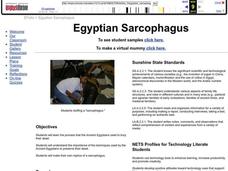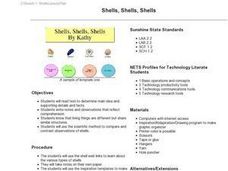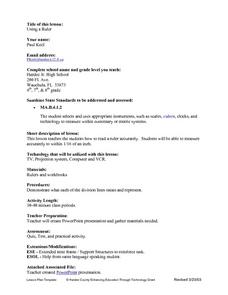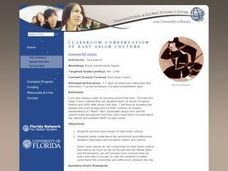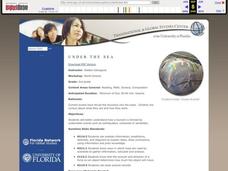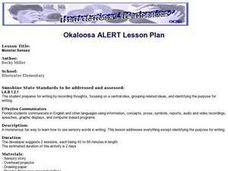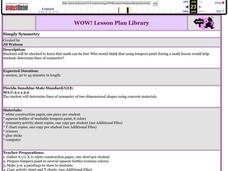Curated OER
Egyptian Sarcophagus
Students conduct Internet research and then practice the process the Ancient Egyptians use to bury their dead by creating their own replica of a sarcophagus. This helps students examine the importance of the Egyptians' techniques used...
Curated OER
Shells, Shells, Shells
Students read text to determine main idea and supporting details and facts. They use the shell web links to inquire about the various types of shells. Students use Inspiration templates to make a mobile about shells.
Curated OER
Using A Ruler
Students investigate the concept of measurement and using a ruler with accuracy up to 1/16 of an inch. They practice using measurement with a ruler in different contexts. To help with the presentation of the lesson a PowerPoint slideshow...
Curated OER
Our Solar System
Students explore the solar system on the internet and video programs. They investigate the names of each planet and their places in the solar system. They chose their favorite planet and design an advertisement to sell a vacation to...
Curated OER
The Alphabet of Culture
High schoolers research a global culture following teacher-created guidelines and break the culture into small sections. They link the sections and find the influences that each component of culture has on another component.
Curated OER
Our Cultural Classroom
Second graders are introduced to the cultural diversity within their own classroom and relate this diversity to community, country and world. They create a visual family culture poster containing different aspects of their personal culture.
Curated OER
International Food
Students creatively develop a project dealing with a country of their choice. They gain knowledge of other cultures through research. Students develop an essence of food customs and traditions of the country of their choice. They design...
Curated OER
Genetic Disorders with Cultural Roots: International Insects
Students recognize that certain populations have specific genetic disorders that could benefit or harm them in their environment, work out punnett square problems and infer offspring probabilities from results, and provide advantages and...
Curated OER
Vanishing Rainforests: How can We Save Them?
Students focus in on the Amazon Rain forest. They research about various plants and animals that exist in our rain forests. Students develop knowledge of resources that come from our rain forests. They analyze the cause/effect of rain...
Curated OER
Endangered Organism Project
Students examine how different organisms meet the characteristics of life. They study specific endangered species and what caused their endangerment. They vcomplete a power point research project.
Curated OER
Classroom Conservation of East Asian Culture
Students study East Asian culture. They examine the similarities and differences between East Asian and European history and culture. They produce project presentations to "teach" their classmates about very specific cultural traits...
Curated OER
Under The Sea
Second graders study how a tsunami is formed by underwater events such as earthquakes, volcanoes or landslides. They discuss what they knew about living and non-living things in the ocean.
Curated OER
Grow Frog Grow
Students begin a KWL chart to determine what they know about frogs. They watch a video and listen to a read aloud of Karen Wallace's Tale of a Tadpole before adding what they now know to the chart. They access the Internet, look at a...
Curated OER
Machines: Not So Simple
Learners examine the names and images of simple machines in a matching activity. They build a simple machine using K'NEX before taking and printing out a digital picture of their example. They complete five station activities based on...
Curated OER
Genes, not Jeans
Fifth graders examine the difference between dominant and recessive genes, and what happens when genes are combined. They complete a worksheet on genetics after observing if they can wiggle their ears or roll their tongues. They...
Curated OER
Greater Gator Takes a Chomp
Second graders discuss alligators before making an alligator out of paper plates. They use the mouth of the paper plate alligator to show greater than, less than, or equal to while the teacher models different sets of hornets on the over...
Curated OER
Monster Senses
Second graders listen to a story that contains many sensory words to describe an object. They listen a second time using a signal to indicate when they hear a sensory word. They write a short story about a monster using appropriate...
Curated OER
Rockin' Rock Cycle
Students label a diagram of the rock cycle with correct labeling and writings in science log. They define 3 types of rocks: igneous, sedimentary, and metamorphic and label the stages of the rock cycle and explain the process.
Curated OER
It's Cool to Know the Rule in School!
Students work with partners taking turns using the teacher-made input/output boxes. Two students will be the tellers, while the other two are the customers. The tellers stand behind the box, and know the rule. When the customers put in...
Curated OER
Conservation Connection
Students work in groups to create a script for a one minute commercial on how to conserve our reusable energy sources. When the scripts are written, explain to the students that a story board is similar to a cartoon.
Curated OER
Simply Symmetry
Young scholars make pictures with squeeze bottles of tempera paint, and fold the paper to show lines of symmetry. They complete a T chart to showing lines of symmetry. They access a website to complete a symmetry activity.
Curated OER
Understanding Place Value
Student examine the place value of digits in number up to 1000. They participate in a modeled lesson about identifying place values. They access a math program online to practice this skill and complete worksheets.
Curated OER
Probability Polly
Young scholars evaluate if an event is certain, probable, or impossible. They design and create a spinner to be used in a game which demonstrates the possible outcome of an event.
Curated OER
Write From the Beginning
Students discuss the earliest form of writing, pictographs and view several examples. They then create their own hieroglyphics and write a short story using them. They then create and label a timeline including methods of writing prior...


